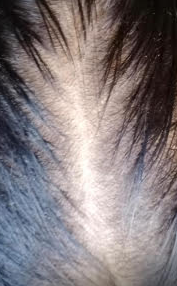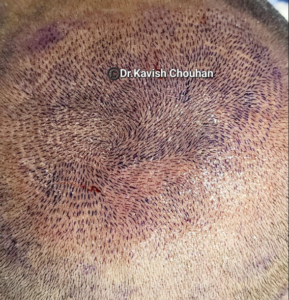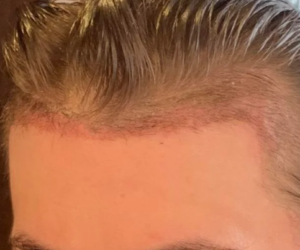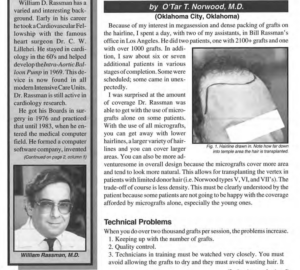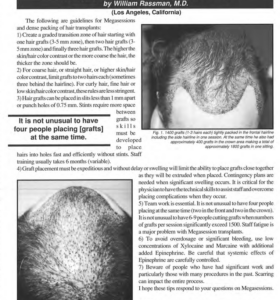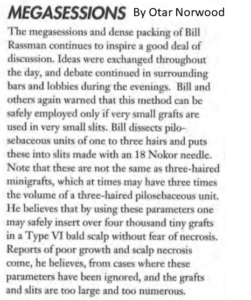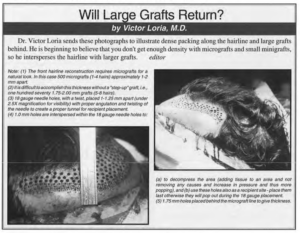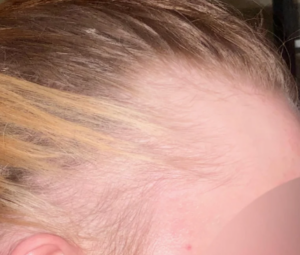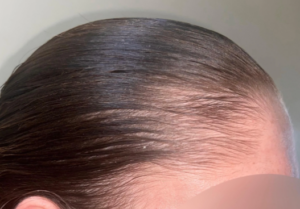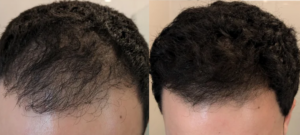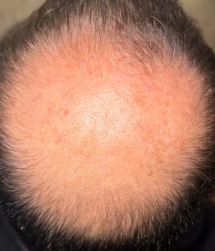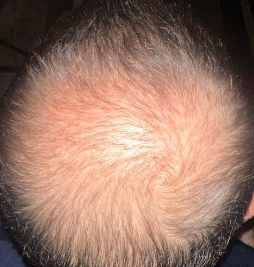Polycystic ovary syndrome PPCOS) is the most common endocrine disorder in women of reproductive age. ] The syndrome is named after cysts that form on the ovaries of some women with this condition, though this is not a universal symptom and not the underlying cause of the disorder. Women with PCOS may experience irregular menstrual periods, heavy periods, excess hair, acne, pelvic pain, difficulty getting pregnant, and patches of thick, darker, velvety skin. (Taken from Wikipedia). This woman also present with thinning hair, a common occurrence in such women. The single best treatment for this condition is Scalp Micropigmentation, which acts as a concealer and will make her hair look fuller.
There is a lot of rumors about finasteride side effects the most known as Post-Finasteride syndrome. But what about the opposite? Are there people who actually experienced a better mood or increased libido or both while on 5ar inhibitors? Is it uncommon? Or more common then the already rare classic sides? What causes this?
More people get an increased libido and sexual performance than people who get Post-finasteride syndrome. I say that because in my career, I have written more than 10,000 prescriptions for finasteride, and I never saw a case of Post-finasteride syndrome. Still, I have had many reports on the increased libido and sexual performance of my patient population. Dr. Bob Haber polled more than 50 high-quality hair transplant surgeons, and none of them had seen a case of Post-finasteride syndrome in their practice.
I have a question regarding your philosophy on receiving a hair transplant before the age of 25. I have read over your comments written on Reddit and Baldingblog and I want to know why you feel that way and if you make exceptions?
I make exceptions to that rule but require the following:
- Develop a Personalized Master Plan, which includes assessing the donor supply quantitatively and qualitatively.
- Making sure that I am convinced that I know the worst-case scenario for balding in that patient
- MAking sure that the patient is mature and understands the hair loss process over his lifetime
- Making sure that the patient has the finances to deal with a worst-case scenario.
If you want to go on this trip with me, then I need to see some photos to show your balding, and one of them should be a frontal view with your hair pulled back and your eyebrows lifted high so that the creases on the forehead show up. This will show me anatomical landmarks to measure where your hairline belongs and more about what a normal hairline should look like. Please tell me what you don’t like about your hairline and overall hair situation. The photos are confidential, and the initial consultation is free (unless I prescribe medications to you). Please include your phone number and the best times to reach you, as I like to establish a connection with each person I am helping, and in your case, I have to get to know you so that I am comfortable that you can meet my criteria.
First picture was in feb, 2nd picture was in June. Have been on topical min since 1 year with no results, decided to upper the dose from 1x to twice a day. Was followed by a shed but I think you can see new hair in the hairline now. Also I added fin 2 months ago, but i think that didn’t had any impact yet. I’m just extremely scared that I’m a non responder or something.
My question is. Picture a hair transplant candidate, wavy dark hair on light olive skin. Needs about 3.000 grafts and is on 1mg of finasteride/day.
Two options : A FUE operation, let’s say all 3K grafts may be extracted from the safe zone. Or, a FUT operation instead. All other factors (healing time, discomfort, price, scar) excluded. Sole criterion is the final cosmetic result. Given that FUT extracted grafts are considered , generally, healthier , bustier and less damage prone, could you give an (enen rough) estimation, on how much better would the FUT cosmetic result be? (A percent % number would be helpful, like 15% better result from FUT , or something like that)
I have seen publications where patients had FUE on one side of their head and FUT on the other, and I respect the doctors who did this because they know how to do both competently. The reports indicated that there was no difference between the two. The issue you may be missing is that the hair thickness (fine, medium, or coarse) is more important a determinant of what you would look like than FUE vs FUT. Also, the need for 3000 grafts is very dependent upon hair thickness, as men with coarse hair often require a lesser number of grafts than a man with fine hair, and even with a change in the number of grafts, the man with the coarser hair will have more fullness than the man with fine hair.
I wanted to share this fantastic photo of a patient transplanted in the crown by Dr. Kavish Chouhan from Delhi, India (tap on the image to enlarge). For a patient with enough donor hair, this photo shows the details of the graft design, following the swirl in exquisite detail. Congratulations to Dr. Chouhan.
I received 1500 grafts in the frontal hairline and 500 in the temple peak area.
Was this balding? If it was, you almost certainly lost miniaturized hairs elsewhere on your head from the surgery. If you were not on finasteride and didn’t lose any hair volume, that clearly suggests you were not balding. I question the use of 2100 grafts for such a small area. Do you know if the surgery was necessary? Will it look as natural as it did before the surgery? Using 2100 grafts reflects 25% of your total lifetime donor supply (assuming your donor density was average). I am questioning the depletion factor here if you have balding.
Richard Shiell’s and Dr. O’tar Norwood’s comments were screenshots discussing my use of Megassions, transplanting between 2000-4000 graft. At that time, I was the only surgeon in the world performing 4000 grafts/sessions, publishing further on my early work in article #2 below. What I see in the screenshot of the photos of my patient, even meets my standards today, when most surgeons of the time were still performing plug surgery. You should know that performing such large procedures came at a great price to me, as I was relentlessly attacked at hair meetings because most other surgeons were still stuck in the “Plug Mentality,” performing 50-100 plugs per procedure. My surgeries could run 10 hours, but theirs ran about 1-3 hours, so it is easy to understand that they didn’t have the staff nor the skill to adopt these larger sessions with tiny grafts. The last article showed a compromise between an extensive session of plugs with some tiny grafts in the leading edge of the hairline (that wouldn’t work well for these patients, even at that time). Click to Enlarge the article you want to read, below.
I’ve been reading a lot about male pattern hair loss lately(androgenetic alopecia). Most often finasteride is said to be a requirement for hair loss and if you don’t use it, it’s an uphill battle.
From my understanding (if nutrition, hormones, exercise, etc is good) DHT causes hair loss due to reduced blood flow and shrinking of the hair follicle. If so, why wouldn’t minoxidil which increases blood flow and even brings back hairs from a baby state to a terminal hair during usage, be enough? Microneedling has a very similar effect, with great backing.
DHT blockers cause issues for many with varying effect. It changes your hormone levels, there’s no question about it. Most doctors I spoke to were against that as a young male, because of the terrible repercussions. I did however take Min + Fin solution for 3 weeks (local treatment, no pills). Did blood work and have higher estradiol. Will get further testing, but not interesting on messing myself. Off fin and will retest myself again after stabilization (month later). This question was taken from Reddit 12/15/2024 with my answer below.
I can’t write a textbook for you in answering your questions, so I am going to discuss only two classes of drugs, (1) DHT blockers and (2) Minoxidil.
DHT blockers work effectively at the hair follicle level blocking DHT in a competitive inhibition with the enzyme 5 alpha-reductase with 70% effectiveness for finasteride and greater than possibly greater than 90% with dustasteride. DHT works in many body organs, so blocking at the hair follicle level, will lead to blocking at other organ systems as well. Dutasteride blocks more receptors than finasteride and it has not been approved for hair loss by the FDA in the US. Finasteride was the first drug to be approved for DHT blocking hair loss drugs around 1996-7 timeframe.
Minoxidil was developed as an antihypertensive drug, which did not work consistently at controlling blood pressure; however, many women complained about hair growth on the face and body when taking it. When it was applied topically, it grew hair and less was absorbed systemically to impact blood pressure significantly. The mechanism of action is not that is increases blood flow as most people believe, it has its effect: by stimulating “ASC motility and increases paracrine growth factor signaling. Minoxidil-stimulated secretion of growth factors by ASCs that may enhance hair growth by promoting Dermal Papilla proliferation.” Further, “Minoxidil directly promotes hair growth via the stimulation of dermal papilla (DP) and epithelial cells. Reference: https://pmc.ncbi.nlm.nih.gov/articles/PMC5877552/
So, as you see from above, both classes of drugs have different modes of action to get to hair growth. Minoxidil has been around much longer, and in countries like India, it has been used well before finasteride was even discovered as a drug for treating hair loss in genetic balding. So if one drug doesn’t work, switch to the other, or sometimes take both.
Minoxidil does not work like microneedling, see here for mechanism of action: https://baldingblog.com/does-microneedling-really-work/
TI was starting my transition and noticed my mpb was beginning to progress faster, even though I was blocking my testosterone. On top of my temples receding, I also started showing signs of retrograde alopecia. My doctors still don’t know if it was telogen effluvium with an unknown cause or my androgenic alopecia worsening from stress. I got bloodwork done and my DHT levels had actually risen from when I first started my transition. So that’s why we added finasteride onto of the spiro.
I have seen minoxidil do this as well. The hairs are growing fairly forward on your hairline, too forward to reflect more than your original juvenile (female) hairline. I suspect this is a side effect of minoxidil reinforced by Estrogen. Do you have new hair growth in any other place on your body? If so, it suggests a minoxidil effect; if not, it would reflect a combined minoxidil and Estrogen effect. It would be interesting to see your 10-year-old hairline. That would shed light on where your hairline should be with all the changes you are precipitating.
Dr. Erdogan is possibly the best doctor in Turkey. These types of results are not uncommon in his hands. Congrats to both the doctor and the patient for this amazing result.
12 Month Update – Smile Hair Clinic – Dr. Erdogan
byu/doegotshwag intressless
Dr. Mohebi and I wrote this article a while ago, but I thought it was worthwhile to offer it to baldingblog readers.
https://www.ishrs-htforum.org/content/htfi/18/2/41.full.pdf
I’ve observed that I am definitely allergic to Finasteride, and my symptoms; 1- As soon as I wake up,I start sneezing, and I have a stuffy nose (not so bad but definitely stuffy) 2- I feel like I need at least one hour to wake myself up. The sneezing is the worst one, it starts at the morning and continues until around evening. Normally, I was having these symptoms every day, but I started taking EoD 1mg, it helped but not the way I wanted it to be. I am desperate for any suggestions or alternatives.
This is the first time I heard symptoms like your report; however, based upon your report, I would consider that this is possibly some allergic reaction. If you stop the oral finasteride, do the symptoms go away? You can switch to a topical liposomal finasteride in which as much as 82% of it stays in the scalp.
Page 5 of 1241

